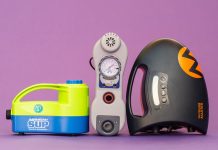The best part of owning an inflatable standup paddleboard is the fact that you can throw your board in the trunk of a car, drive to the beach, pump up the board and be on the water without ever having to worry about tying your board to the roof.
The worst part of owning an inflatable paddleboard? That third step: using a paddleboard air pump to inflate the board from completely flat to rock hard. It’s one of the things that scares people away from buying inflatable paddleboards. The good news, however, is that modern SUP pumps are designed to make the task a little bit easier. And, since there’s an industry standard on the inflator port, you can easily upgrade if the pump that came with your board isn’t getting the job done for you.
SUP pump basics
Without getting too technical, a SUP inflation pump is just that: an air inflator that’s similar to what you would use to pump up a bicycle tire. We’ll talk about electric pumps shortly, but nearly every inflatable paddleboard on the market today will come with a high-volume hand pump that looks a bit like a bicycle floor pump on steroids.
When you look at a pump you’ll see four main parts: the handle, the main cylinder, the feet and a detachable hose. Most pumps will have an air gauge built into the handle that will tell you how much pressure you’ve inflated your board to. Most good pumps will also have a “plug” of sorts that allows you to switch between high-volume inflating and high-pressure inflating. We’ll get into that in a moment. When it comes to SUP pumps, size does matter as a dual cylinder pump (where it looks like two silos instead of one) will allow you to get air into the board faster.

Why recommended air pressure matters
Every inflatable board manufacturer will provide a recommended air volume which will be listed in PSI (pounds per square inch). This number will vary by brand, length and type of board, but will usually be in the 12 to 18 PSI range.
This is a critical number because it’s what the board manufacturer deems to be the ideal pressure you should pump your board to in order to have the most rigid and stable platform to stand on possible.
Think of the PSI recommendation in the same way you think of vehicle tires: the manufacturer has put lots of time and money into developing the product based on a very specific pressure parameter, so stick with what they’re suggesting. The board will perform much better if you do. Underinflate and the board will feel like you’re paddling a piece of soggy cardboard. Overinflate and you risk putting too much pressure on the seams and board construction.
One important note is that just because a board has a higher recommended pressure, doesn’t mean it’s guaranteed to be a more rigid ride. Many factors go into the rigidity of an inflatable board, and the wider the board often means the less pressure required.
The key point here is that accurately inflating your board to a particular PSI is important, so if your paddleboard pump doesn’t have an air gauge on it, it’s likely worth upgrading.
High volume vs. high pressure
As mentioned earlier, most air pumps for inflatable standup paddleboards will have a plug or switch that allows you to change from high-volume pumping to high-pressure.
When you’re manually inflating something as big as a SUP, having this feature will make life much easier and will cut down on pumping time dramatically. Think of it like a water hose: The high-volume setting is like a garden hose with no nozzle on it that allows a large amount of water to flow out quickly. The high-pressure setting is like when you cover the end of the hose with your thumb. Far less water is coming out of the hose, but you’re able to shoot it like a water gun.
Unlike a hose, however, where the amount of water flowing is controlled by a tap, when it comes to a manual SUP pump, you’re the tap. It’s your effort that fills the board.
As you start inflating the board, make sure your pump is on the high-volume setting. This will allow you to make quick work of getting lots of air into the paddleboard. As it fills up, the pumping action will start to get more difficult. At this point, switch it over to high-pressure, and you’ll notice that you won’t be adding as much air, but you’ll be able to hit the high pressure required with less effort.
How to inflate a standup paddleboard
Pump up a standup paddleboard once and you’ll be a pro because there’s not much to it. Here’s the process:
- Set your SUP on the ground face up and unroll it as much as you can. Don’t put your fins in yet.
- Make sure the release valve is not pushed in. This is a mistake everyone makes at least once. You’ll be able to fully inflate the board, but as soon as you go to release the hose, all the air will come shooting back out.
- Assemble the pump by threading the hose onto the handle and then twist the other end of the hose onto the valve, making sure it’s locked on tight.
- Put at least one foot on the pump feet to keep it stable and start pumping in the high-volume setting.
- When it starts to feel very difficult to add more air, put the SUP pump into high-pressure mode and finish pumping until you reach the recommended PSI.
- Remove the hose from the paddleboard and replace the valve cap.
- Install the fin(s) and leash and head to the water!
How long will it take?
When it comes to using a SUP inflation pump, the harder you work, the faster you’ll inflate the board. Of course, it also depends on how big the board is, and what type of pump you’re using. A large volume, dual chamber, dual cylinder pump is going to allow you to inflate the board in a much shorter amount of time.
In general, however, expect that it will take you somewhere between five and 10 minutes to inflate your board and another five minutes of prep time between getting the board out of the car, getting it unrolled, and then getting the board ready to go into the water. So if your group paddle starts at 10 a.m., expect to arrive 10 to 15 minutes before your friends if you’re the only one on an inflatable and you don’t want to be the reason the paddle starts late.
Electric
Not feeling the desire to get a workout before your workout by pumping up your inflatable SUP?
Electric paddleboard pumps are also a great option. Plug them into your vehicle’s 12-volt outlet, insert the hose into the paddleboard and turn on the switch. Some pumps will inflate your board in as little as one minute, and some allow you to preset the desired PSI so it pumps to exactly the level you want it.
The other benefit to electric pumps is that many have a deflate option, which will allow you to suck the air out of the board, making it easier to roll or fold to pack away after using it.
Will SUP pump X fit my inflatable paddleboard?
The vast majority of inflatable SUPs use a type of inflation insert known as a Halkey-Roberts valve. This refers to the technology where the valve allows air to go in, but not escape, unless you depress and lock the release valve in. This is what releases the air in the board rapidly, leading to the loud and sometimes alarming sound of air rushing out of your board post-paddle.
Paddleboard inflation pumps have fittings for the Halkey-Roberts system on their hoses, and don’t require any sort of adaptor. SUP-specific electric inflators also typically use this type of hose. More generic electric pumps may come with the adaptor, or you may need to buy an aftermarket piece.
What’s it going to cost me?
Fortunately if you’re buying an inflatable standup paddleboard, you’re likely going to get a quality pump included. But if you’re looking to upgrade to something a bit more beefy or that can help you inflate the board faster, you could spend anywhere between $50 and $150 for a manual pump and $75 to $300 for an electric pump.
Oops, I broke it
Considering they’re almost entirely plastic, the pumps that come with most inflatable boards are surprisingly durable. If anything is going to break, it’s likely going to be a hose, which is easily replaceable, or the gauge, which can be more of a challenge. A local outdoor or paddling gear shop can help you order replacement parts if needed.
When it comes to electric pumps, unless you have some mechanical expertise, disassembling them is discouraged. Most, however, are built to handle some abuse and come with good warranties.






